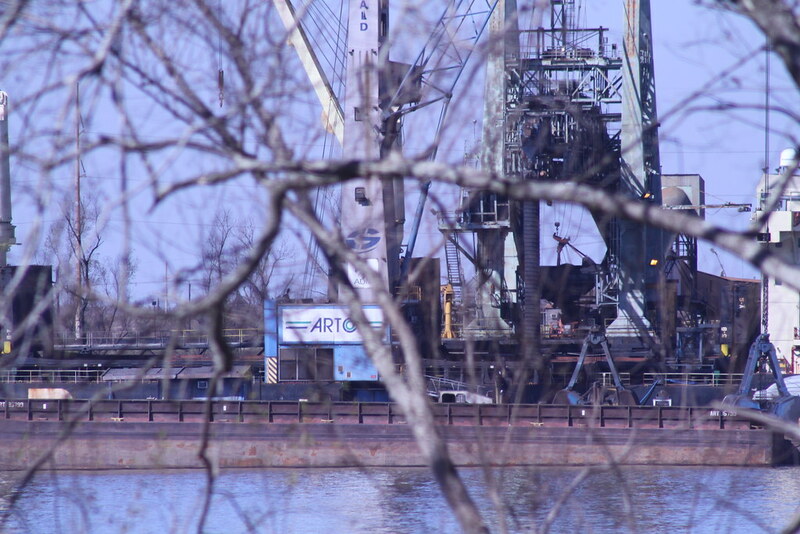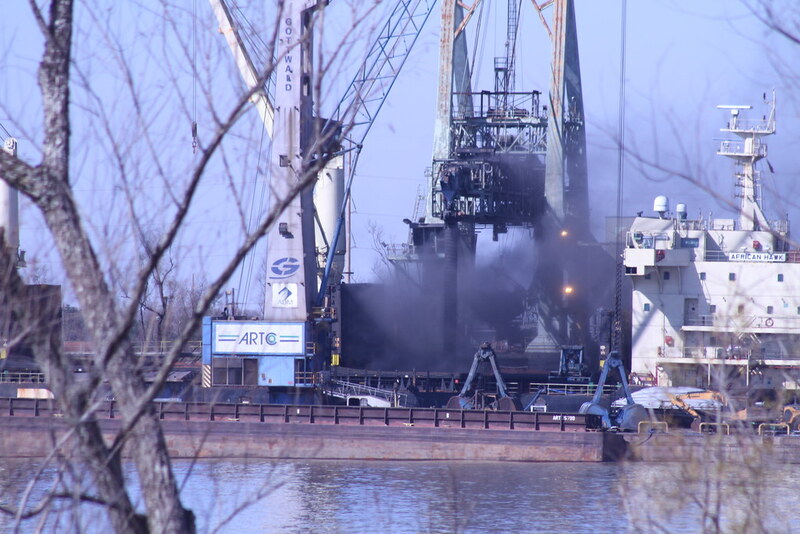Several people in our Public Lab community are concerned about various kinds of airborne emissions, and what we as the public can do about them. One of the most accessible methods for assessing emissions is to estimate the opacity of emissions (I’ll explain a bit about this below) using EPA’s Method 9. Some community members have gone through Method 9 training and have found it very useful; others have found that it hasn’t been useful for their situations. I recently went through the training and became certified for Method 9, and I want to share some of the things I learned in that process, and my thoughts about the potential utility of Method 9 for various situations and concerns. Please comment and share your thoughts too!
What is opacity and what is Method 9?
Opacity is the extent to which light is blocked, or the extent to which you can’t see through an emissions plume. Opacity is caused by small particles and gases that absorb, reflect, or refract light. Particles that are similar size to visible light wavelengths (390-700 nm) can scatter visible wavelengths effectively, muting light rather than preferentially reflecting a given color; carbon particles (like soot) effectively absorb light, largely contributing to plume opacity.
Method 9 is a method to standardize the direction and distance from which you observe an emissions plume, with regards to both the plume direction (related to wind direction), sun direction, and stack (or pile) height. The basics of this include that the sun needs to be at your back, you need to be looking perpendicular to the plume, and you should be between “3 stack heights” (or, three times the height of wherever the emission is coming out or off of the source) and a quarter mile from the source. These guidelines can be very tough to follow, however, given potentially limited access to unobstructed views of the emissions source. Method 9 recommends that you monitor emissions in the morning or afternoon -- not midday -- and move if the wind suddenly changes direction. Again, this is easier said than done, especially if you are not directly on the property where emissions are occurring. The training for Method 9 includes a lecture component and field training where you practice estimating the opacity of plumes, training your eyes to discern smoke opacities to ~5% resolution.
Starting as early as 1859 (in the City of New Orleans vs. Lambert case), smoke opacity has been used to regulate air pollution. Today, states regulate plume opacity for point-source emissions (like from smokestacks) and most regulate opacity of fugitive emissions. Common opacity limits are 20% opacity, which means that 20% of light is blocked, or you can only see through the plume to see 80% of the background behind the plume. In practice, 20% opacity is visible, but can be hard to differentiate the bounds of the plume -- it’s really not thick smoke. Method 9 is used to measure opacity and enforce state emissions opacity regulations; if you are certified in Method 9 (which anyone can do), you can report violations and prompt an enforcement response.
What are some of the limitations of the method?
Method 9 can be very useful, but also has many limitations.
First and foremost, Method 9 only allows you to assess visible emissions -- it provides no ability to ascertain the chemical composition of what is being emitted, and is not useful for most vapor emissions.
Steam plumes are a significant complicating factor too, as steam is not subject to opacity rules, and it is often difficult to distinguish whether or not a plume contains steam or not.
The physical restrictions of conducting Method 9 also limit its utility since it is often not possible to view plumes with the specific siting requirements mentioned above.
A significant limitation of Method 9 is that there is no residual evidence of the visible emissions observed, which can limit agency’s ability to enforce violations. It is recommended that people conducting Method 9 also take photographs of the site and the emissions to document what was observed. There is also a digital camera alternative to Method 9, which has its own limitations, and is discussed below.
Another limitation is that persons need to be re-certified every 6 months, with each certification training/test fee ~$200. In some places, this fee is waived for citizens and covered by permit fees for industry, but in most places each person is responsible for paying their certification fee, and can be exclusionary to people who can’t afford that.
What about fugitive emissions?
In some states, like Wisconsin, opacity limits apply to fugitive emissions too. Fugitive emissions are any emissions from a process that are not through a specified emissions point -- they are construction dust plumes, dust kicked up from unpaved roads, wind-blown dust coming off of sand piles, plumes emanating from blasting, etc. Assessing the opacity of fugitive emissions can be complicated since there often isn’t a distinct plume with a distinct direction, but as long as you are looking through the narrowest/shortest dimension of the emissions, and are following the proper siting requirements (i.e. sun at your back, appropriate distance from emissions point), Method 9 assessments are valid for fugitive emissions. Since fugitive emissions are more sporadic and variable than smokestack emissions, it is recommended that you become familiar with the characteristics of those fugitive emissions before starting your monitoring. It is useful to check out your state’s regulations before starting monitoring too, since some states, like Colorado, unfortunately have exemptions from opacity rules for fugitive emissions.
Where can I learn about emissions opacity regulations in my state?
Visible emissions opacity limits are included in each state’s air pollution regulations. Usually these regulations are searchable online in each state’s administrative codes on the state legislature website. Opacity standards are also included in the “State Implementation Plan” (SIP) which the state develops to detail how the state will achieve the National Ambient Air Quality Standards (NAAQS). Legislative websites and SIPs can both be somewhat onerous to navigate, so it may be most efficient to search for “opacity” on your state’s environmental agency (usually a DEP, DEQ, or DNR) website.
What are some similar methods?
There are four other methods recognized by EPA that are similar to Method 9.
Alternative Method 82, also known as ASTM D7520, is the “Digital Camera Opacity Technique” (DCOT) that can be used in place of Method 9 when approved. Note that Alternative Method 82 is only approved to demonstrate compliance (or lack thereof) with federal opacity limits, but not opacity limitations set by the state or municipality. Alternative Method 82 does have the advantage of having a data record of visible emissions, however, it can be very difficult to actually conduct. First, the DCOT system, which includes a digital camera, a photo analysis software platform, and a results assessment and reporting component, needs to be certified, and this certification process is more arduous than that of Method 9. The DCOT operator has to complete a manufacturer-specified training course, and follow all of the Method 9 siting requirements (and a couple of additional limitations), and then the images also generally have to be sent to a third party for analysis. Also, as of today, there is still only one DCOT system that is commercially available and certified to conduct Alternative Method 82, and the software licenses can be thousands of dollars per year. In addition to the cost for the DCOT system and analysis, it also takes longer, and cannot immediately identify opacity violations (it takes processing time). Therefore, while there are some definite advantages of Alternative Method 82 (notably the data record with photographs), there are currently considerable drawbacks. The company whose training I took, AeroMet, recommends that the EPA address these drawbacks to make the method more accessible and feasible for people to actually use.
Methods 203a, 203b, and 203c are alternative methods for Method 9 for slightly different types of opacity limitations: time-averaged, time-exception, and instantaneous limitations, respectively. Each of them are the same general procedure, but in 203a total time assessed can be 2-6 minutes (whereas Method 9 requires 6 minutes), 203b averages the amount of time that emissions are above the opacity limit, and 203c takes observations every 5 seconds for 1 minute (whereas Method 9 takes observations every 15 seconds for 6 minutes). For Methods 203a-c to be acceptable for assessing compliance with air pollution regulations, that must be specified in the state implementation plan.
Method 22 is somewhat similar to Method 9, but is used to assess the frequency of visible emissions, not the opacity of those emissions. Method 22 is mostly used for fugitive emissions and gas flares. In Method 22, the observer uses two stopwatches, one to measure total time elapsed, and one to measure the time when visible emissions are present, to determine the frequency and percentage of time that a source is visibly emitting. For Method 22, the observer can be indoor or outdoor and there are fewer siting requirements overall. If industries are subject to compliance assessed by Method 22, it will be stated in the SIP.


4 Comments
Hello Gretchen, I am curious about when the fee is waived and when it is not, as $400 a year is definitely prohibitive for citizen science on a large scale, but might be possible if a community pools their money to appoint one person as 'smoke spotter.'
Reply to this comment...
Log in to comment
Hi Patrick, I am also curious about when the fee is waived and when it's not. I know that in some counties (though I'm not sure if the county is always the granting authority), community certification costs are provided through permit fees for the industry. However, I'm not sure what factors into this. I've heard that in other places, the state environmental agency waives the fee (though I'm not sure if that is state-provided training, or third-party training like Aeromet), but I'm not sure the rhyme or reason to when the fees are waived and when they're not. @ccampos and @MD2020 -- do you know when, where, or why sometimes permit fees are used to pay for community observer certification?
Is this a question? Click here to post it to the Questions page.
Reply to this comment...
Log in to comment
one other tool you may want to consider is something like a haze cam, see http://hazecam.net/
These are typically used for wide open areas but I think it could be adapted for use in smaller areas. The advantage of a fixed cam taking photos over time is you can compare when the source is on and off to get a better sense of impact.
Reply to this comment...
Log in to comment
Does this count? It is an operations fugitive emissions point source for Rain CII Carbon in St John Parish, Louisiana.
I can't get within a quarter mile, this photo is from half a mile away.
I don't control when the operations happen, they happen mostly in the afternoon until early morning.
LDEQ has a Method 9 certified staff member, but i've only ever seen them dismiss complaints--LDEQ usually comes to inspect two weeks after the incident, and ~75% of the time, the facility isn't conducting the same operations two weeks later.
Rain CII Carbon high density Plume OC3876 https://www.flickr.com/photos/healthygulf/51876201048/in/album-72177720296617562/
Before operations https://www.flickr.com/photos/healthygulf/51876129266/
During operations --the Yellow pylon and the Green western strut of the loader disappear.
Is this a question? Click here to post it to the Questions page.
Reply to this comment...
Log in to comment
Login to comment.